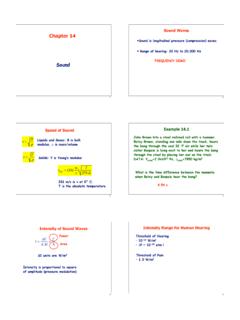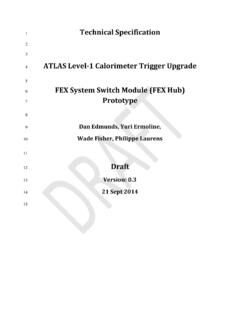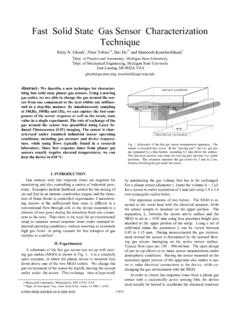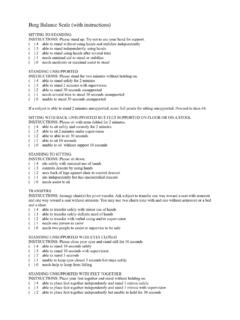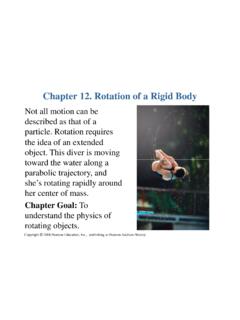Transcription of Rotational Motion: Moment of Inertia
1 Experiment8 Rotational motion : Moment Objectives Familiarize yourself with the concept of Moment of Inertia ,I, whichplays the same role in the description of the rotation of a rigid bodyas mass plays in the description of linear motion . Investigate how changing the Moment of Inertia of a body affects itsrotational IntroductionIn physics, we encounter various types of motion , primarily linear or rota-tional. Today we will investigate Rotational motion and measure one of themost important quantities pertaining to that: the Moment of Inertia . Theway mass is distributed greatly affects how easily an object can rotate. Forexample, if you are sitting in a spinning office chair and extend your armsout away from your body, your rotation speed will slow down. If you thenpull your arms back in as close as possible, you will start to rotate muchfaster than when your arms were extended. This illustrates that not onlymass but also how it is distributed ( Moment of Inertia ) affects Rotational motion : Moment of Key ConceptsYou can find a summary on-line at for keywords: Moment of Inertia , torque, angular TheoryIf we apply a single unbalanced force,F, to an object, the object willundergo a linear acceleration,a, which is determined by the unbalancedforce acting on the object and the mass,m, of the object.
2 Newton s SecondLaw expresses this relationship:F=mawhere the mass is a measure of an object sinertia, or its resistance tobeing Rotational motion , torque (represented by the Greek letter ), isthe Rotational equivalent of force. Torque, roughly speaking, measures howeffective a force is at causing an object to rotate about a pivot point. Torque, is defined as: =rFsin( )( )whereris the lever arm,Fis the force and is the angle between the forceand the lever arm. In this lab the lever arm,r, will be the radius at whichthe force is applied ( the radius of the axle). The force will be appliedtangentially ( perpendicular) to the radius so is 90 and sin(90 ) = 1making Eq. become = s Second law applied to Rotational motion says that a singleunbalanced torque, , on an object produces anangularacceleration, ,which depends not only on the mass of the object but on how that mass isdistributed, called the Moment of Inertia ,I.
3 The equation which is analogoustoF=mafor an object that is accelerating rotationally is =I ( )where the units of are in Newton-meters (N*m), is in radians/sec2andIis in radian is an angle measure based upon the circumference of a circleC= 2 rwhereris the radius of the circle. A complete circle (360 ) is said to have 2 , a 1/4 circle (90 ) is /2 updated January 9, TheoryThe Moment of Inertia ,I, is a measure of the way the mass isdistributed on the object and determines its resistance to rigid object has a definite Moment of Inertia about aparticular axis of rotation. The Moment of Inertia of a collection of massesis given by:I= mir2i( )If there is only one mass (as shown in Fig. ) then Eq. becomesI=mr2. (In order to simplify the calculation we have assumed that themassmis a point at the end of the lever armrand the rod it is attachedto is massless.) To illustrate, we will calculate the Moment of Inertia for amass of 2 kg at the end of a massless rod that is 2 m in length:I=mr2= (2 kg)(2 m)2= 8 kg m2If a force of 5 N were applied to the massperpendicularto the rod (tomake the lever arm equal tor) the torque is given by: =rF= (2 m)(5 N) = 10 N mBy Eq.
4 We can now calculate the angular acceleration: = I=10 N m8 kg m2= rad/sec2 Figure : One point massmon a massless rod of radiusr(I=mr2).Last updated January 9, 2015878. Rotational motion : Moment of InertiaThe Moment of Inertia of a more complicated object is found by addingup the moments of each individual piece. For example, the Moment ofinertia of the system shown in Fig. is found by adding up the momentsof each mass so Eq. becomesI=m1r21+m2r22. (Note that Fig. isequivalent to the sum of two Fig. components.)Figure : Two point masses on a massless rod (I=m1r21+m2r22). In today s labToday you will measure the Moment of Inertia for several different massdistributions. You will make a plot of the Moment of Inertia ,I, ,the radii that your masses were placed at, and determine if the Moment ofinertia does indeed depend on both mass and its distribution. Your setupwill resemble Fig. where the rigid body consists of two cylinders, whichare placed on a metallic rod at varying radii from the axis of rotation.
5 Youwill assume the rod is massless and will place the masses,m1andm2, anequal distance from the center pivot point so thatr1=r2=r. For this caseEq. then becomes:I=m1r21+m2r22= (m1+m2)r2( )88 Last updated January 9, In today s labA schematic of the equipment you will be using today is shown in Fig. masses and rod are supported by a rotating platform attached to acentral pulley and nearly frictionless air bearings. If the two masses areplaced on the axis of rotation (sor= 0), then the measured Moment ofinertiaIis the Moment of Inertia of the rotating apparatusaloneplus themoment of Inertia of each of the two cylinders about an axis through theirown centers of mass, which we ll callI0. So when the masses are placed atr= 0,I=I0. Now if the two masses are each placed a distancerfrom theaxis of rotation Eq. becomes:I= (m1+m2)r2+I0( )Compare Eq. to the equation for a straight line:y=mx+bNotice that a plot be a straight line.
6 The slope of thisline is the sum of the masses (m1+m2) and they intercept : Schematic of the Moment of Inertia verify that the Moment of Inertia ,I, does indeed depend on howthe masses are distributed you will use the apparatus shown in Fig. tocalculate the angular acceleration, , and torque, , of the rotating massesand then use Eq. to calculateI. You will plot your updated January 9, 2015898. Rotational motion : Moment of Inertiaand check that your slope is consistent with your mass value (m1+m2)thus verifying Eq. The Excel spreadsheet requires several calculationsto arrive at values for the angular acceleration and torque that are used tocalculate the Moment of Inertia . The needed formulas are outlined order to get your rigid body to rotate you will wrap a string aroundthe central axle (also called the central pulley) and run it over the sidepulley to a known weight,M, as shown in Fig. When you release theweight from rest just below the side pulley and let it fall to the floor, thetension,T, in the string will exert a torque, , on the rigid body causing itto rotate with a constant angular acceleration.
7 NOTE:Be careful to notmix up the symbol for tension (T) with the symbol for torque ( ) and thesymbol for linear acceleration (a) with the symbol for angular acceleration( ) in the following angular acceleration ( ) of your rigid body is related to the linearacceleration (a) of your falling mass by: =Linear accelerationRadius of axle=aR( )whereRis the radius of the central axle at shown in Fig. : A top view of the central axle with radiusRand the stringproviding the will use your knowledge of the equations of motion to find the linearaccelerationaof the weight as it falls to the floor. Remember that theposition,y, of an object released from rest (vi= 0) with an initial positiony0(in your casey0=h, the starting heighthabove the floor) is found using:y=h 12at2( )90 Last updated January 9, Equipmentwhere the floor is defined to be at a height ofy= 0. Since the final positionof your mass will be the floor,y= 0, and Eq.
8 Can be rearranged to findthe linear acceleration,a:a=2ht2( )wheretis the time it takes the weight to fall to the floor. Using your measuredvalues for the time and height you can calculate the linear accelerationawhich can then be used to calculate the angular acceleration that will beused in Eq. you need to find the torque so you can calculateIusing Eq. that torque was defined in Eq. as the force applied times thelever arm when the force is applied tangentially: =rF( )In this lab the force (F) comes from the tension (T) in the string that isacting perpendicular to the lever armr, which here is the radius of thecentral axle (R), as shown in Fig. So for this experiment Eq. : =R T( )The tension in the string,T, comes from the weight which is hanging off theside pulley (see Fig. ). By drawing the free-body diagram acting on thehanging mass and using Newton s Second Law, the tension in the string is:T=Mg Ma( )whereMis the amount of mass hanging below the side pulley,gis theacceleration due to gravity andais the linear acceleration given in Eq.
9 You have all of the pieces to calculate the Moment of inertiaIof therigid body using Eq. (I= / ). Equipment Two cylindrical masses Hanger with mass Air bearing with central pulley StringLast updated January 9, 2015918. Rotational motion : Moment of ProcedureIn this experiment, you will change the Moment of Inertia of the rotatingbody by changing how the mass is distributed on the rotating body. Youwill place two cylindrical masses at four different radii, such thatr=r1=r2in each case, on a metallic rod. You will then use your measurements tocalculate the Moment of Inertia (I) for each of the four radial positions ofthe cylindrical masses (r). The sum of the two cylindrical masses (m1+m2)can then be found from a graph and record the masses of the hanging mass,M, and the twocylinders, the cylinders on the horizontal rod such that the axes of thecylinders are along the horizontal rod as far away from the centeras possible (as shown in Fig.)
10 Make sure the thumbscrew oneach cylinder is tightened. The center of mass of each cylinder MUSTbe the same distance (r) from the axis of rotation ( ).Figure : View of the apparatus with 2 masses at the same the uncertainty inr(called r). This should include boththe uncertainty in reading your ruler and the uncertainty in locatingthe cylinder s center of updated January 9, the air supply on, attach the hanging mass (M) to one end of astring and wind the other end around the central axle (pulley). Thestring should also pass over the side pulley such that the hangingmass is just below the side pulley as shown in Fig. Hold thehanging mass stationary and measure its height (h) using the flooras your reference point. Record this elevation in your spreadsheetand assign an appropriate uncertainty to this to return your mass to this same height for each of the hanging mass and simultaneously start the desktop the mass hits the floor, stop the timer and enter your value inthe spreadsheet undert.
